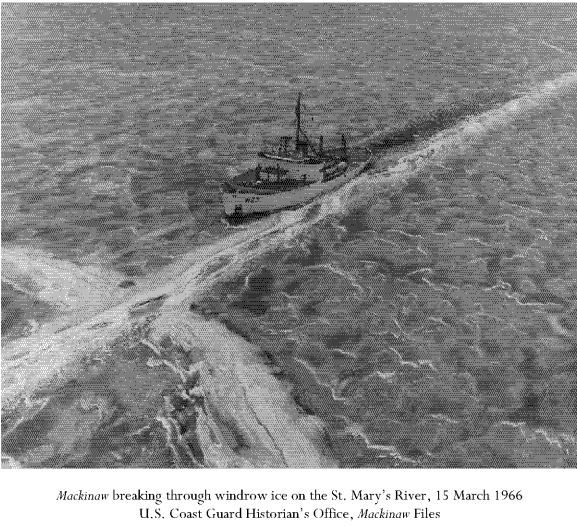WAGB-83 was built during WWII so that the iron ore, limestone and coal could continue to flow during the winter months. WLBB-30 was commissioned in 2006 to replace WAGB-83. These notes are about WAGB-83. WLBB-30 has its own notes.
The home port before it was a museum was in Cheboygan, MI. [HAER-data] It is now moored at the dock in Mackinaw City that was used by the Chief Wawatam ferry.
 |
| US Coast Guard photo via TheMackinaw WAGB-83 was built during WWII so that the iron ore, limestone and coal needed for steel war production could continue to flow during the winter months. It was built in Toledo Shipbuilding and commissioned on Dec 30, 1944. It cost $10m or $171m in 2022 dollars. "Cheboygan remained her home port her entire life." |
 |
| Via MightyMac-old "Coast Guard Cutter Mackinaw on the St. Mary's River in the late 1990s. Photo courtesy of BM1 Mark A. Faught, Station Supervisor at Station (sm) Washington Island. He is in the orange suit at left." |
 |
| Via MightyMac-old "Mackinaw leading freighter Edgar B. Speer down the St. Mary's River on January 22, 2004 - courtesy of USCG" |
 |
| Michigan Film Photographer Karl Wertanen posted This is really cool. This is currently a museum ship up in Mackinaw City. |
Builder: Toledo Shipbuilding Company in Toledo, OH beganconstruction, but fell into bankruptcy. Americancompleted the vessel.Significance: When the Mackinaw was launched, she was the mostpowerful icebreaker in existence. She was specificallybuilt for service on the Great Lakes and the only vesselbuilt in her class. Her long service career, sixty-twoyears, made this ship a hero and an icon not only for themen and for women who served on her, but also for themariners who sailed on the Great Lakes.
 |
| Raymond Roberts, Sep 2022 |
 |
| HAER-data, p20 |
 |
| The bow propeller on the Mackinaw served several useful purposes. When used ahead, the bow prop drew water from beneath the ice, which reduced the buoyancy of the ice. The weighted bow crushed the ice more efficiently because the ice losses support. Additionally, the bow's propulsive force swept the crushed ice back toward the stern and scattered the shattered it. The prop wash also helped reduce friction between the hull and the ice. Conversely, when the bow propeller was reversed the water pushed ahead of the bow moving away any snow atop the ice, thereby taking away the cushioning effect of the snow and allowing the bow direct contact with the ice. Commander McGuiness used the bow propeller during docking and undocking procedures. By using the bow prop ahead and the starboard propeller in reverse, the vessel would move parallel to the dock through the torque of the screws — commonly called "walking the boat." The bow propeller was an important unit within the Mackinaw's complex design. HAER-data, p8 & p24 |
 |
| HAER MICH,16-CHEBO,1- ENGINE #1 LOOKING FORWARD - U.S. Coast Guard Icebreaker Mackinaw, Icebreaker Mackinaw Maritime Museum 131 South Huron Avenue, Mackinaw City, Cheboygan County, MI Photos from Survey HAER MI-121 |
Designers built the Mackinaw around three general characteristics: she was 292 feet in overall length, she had a 74.3-foot beam, she drew 19 feet of water, and she displaced 2,252 tons of water. Inside, six ten-cylinder Fairbanks Morse opposed-piston engines powered the ship, each rated at 2,000 horsepower. Connected to each motor were Westinghouse electric generators that sent 900-volts of direct current to three Westinghouse electric motors. Her twin-screw electric motors generated up to 5,000 shaft horsepower each for a top speed of 18 knots. Normal operations allowed for two main engines per shaft, although three motors could be put online per shaft. The two stern propellers were fourteen feet in diameter and had three blades....Two forward Fairbanks Morse diesel-electric motors drove the bow propeller motor up to 3,300 shaft horsepower. It was similar to the stern propellers (three bladed), but slightly smaller with a diameter of twelve feet.
During ice breaking operations, the ice made certain noises and reverberated through the ship's hull. Mackinaw customs described the variety of ice in culinary terms: saran, mashed potato, pancake, snow cone, and margarita ice. Each individual ice form made certain sounds and produced different pulsations throughout the vessel; breaking ice was loud. There were certain rooms in the ship that required hearing protection when breaking ice due to the deafening noise the ice created while passing against the hull. Designers lined the hull with cork to act as insulation from the cold-water temperatures of the Great Lakes and it helped to buffer the noise.[HAER-data, p12]
"The Mackinaw was the largest and strongest vessel that the Great Lakes had seen and was dubbed the “Mighty Mac”. This ship was capable of breaking 40 feet of wind throw ice and 42 inches of blue ice. With the increased ice breaking capabilities that the Mackinaw brought to the Great Lakes, the shipping channels and commerce remained open year round....The vessel was the largest and most powerful ice breaker anywhere in the world at that time." [mtu]
 |
| This photo has been moved to "US Coast Guard Mackinaw Ice Breakers." |
 |
| This photo has been moved to "US Coast Guard Mackinaw Ice Breakers." |
 |
| This photo has been moved to "US Coast Guard Mackinaw Ice Breakers." |
No comments:
Post a Comment